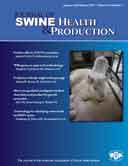Abstract:

Willingness-to-approach behavior of weaned pigs after injection with Mycoplasma hyopneumoniae vaccines
Thomas J. Fangman, DVM, MS, Diplomate ABVP; Anna K. Johnson, PhD; Jeff Okones, DVM; Roy A. Edler, MSc
Complete article is available online.
PDF version is available online.
Objective: To determine if field observations of reduced pig activity after injecting Mycoplasma hyopneumoniae vaccines could be confirmed and quantified by observing willingness to approach (WTA) an observer for 15 seconds.
Materials and methods: Three studies were conducted. Two weeks post nursery placement, pigs 17 to 23 days old were evaluated to determine WTA using the Swine Welfare Assurance Program behavioral protocol. Pigs were observed at 4:00 pm the day before injection and at 4:00 pm 24 hours later, 6 hours post injection. The difference between the two WTA scores is reported as a decrease in percent willing to approach. In Study One, 1832 pigs were vaccinated either with MycoFLEX®(36 pens) or RespiSure-ONE® (36 pens). In Study Two, 2568 pigs were injected with MycoFLEX® (39 pens), RespiSure-ONE® (39 pens), or saline (38 pens). In Study Three, 1750 pigs were injected with saline (35 pens) or not injected (35 pens).
Results: In Studies One and Two, the decrease in WTA was less for pigs vaccinated with MycoFLEX® than with RespiSure-One® (Study One, 11.2% versus 26.8%, P < .001; Study Two, 13.5% versus 35.8%, P < .001). In Study Two, the decrease in WTA did not differ between MycoFLEX® and saline-injected pigs (P = .22). In Study Three, the WTA did not differ between saline- and non-injected pigs (2.0% versus 6.1%, P = .28).
Implication: Willingness to approach a human in a nursery-pen environment may be a sensitive parameter for assessing vaccine reactivity 6 hours post vaccination.
Keywords: approachability, willingness to approach, vaccine
![]() Cite as: Fangman TJ, Johnson AK, Okones J, et al. Willingness-to-approach behavior of weaned pigs after injection with Mycoplasma hyopneumoniae vaccines. J Swine Health Prod 2011;19(1):19-25.
Cite as: Fangman TJ, Johnson AK, Okones J, et al. Willingness-to-approach behavior of weaned pigs after injection with Mycoplasma hyopneumoniae vaccines. J Swine Health Prod 2011;19(1):19-25.
Search the AASV web site for pages with similar keywords.
